The French Revolution Class 9 Questions and Answers Provided helps you to answer complex Questions too easily. You can use them while preparing for board exams and all of them are given by subject experts. Reading NCERT Solutions for Class 9 Social Science History Chapter 1 The French Revolution familiarizes you with the kind of questions appearing in the board exams. Students are advised to read these solutions on a regular basis to score well.
The French Revolution Class 9 Questions and Answers History Chapter 1
Make your learning experience enjoyable by preparing from the quick links available on this page. Use the Class 9 SST History Chapter 1 NCERT Solutions and get to know different concepts involved. All the Solutions are covered as per the latest syllabus guidelines. Knowing the NCERT Class 9 History Chapter 1 Questions and Answers helps students to attempt the exam with confidence.
The French Revolution NCERT Intext Questions and Answers
Question 1.
See figure given below. Explain, why the artist has portrayed the nobleman as the spider and the peasant as the fly.
Answer:
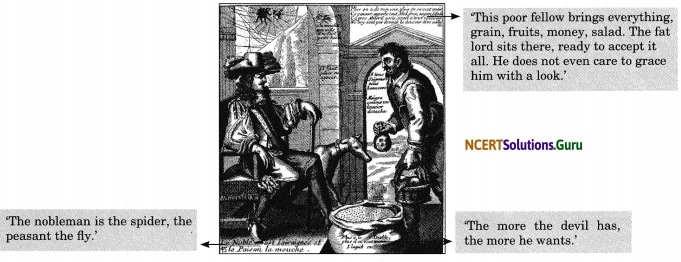
The reason is obvious. The spider is a parasite who feeds on the fly once it is trapped by the spider. Similarly, in the eighteenth century France the nobles exploited the poor peasants under the protection of the government. They extracted feudal dues from the peasants in the forms of tithes and taille. Peasants also had to render all kinds of services to the noblemen.
![]()
This system was highly exploitative. That’s why the artist has portrayed the nobleman as the spider and the peasant as the fly. What the artist wants to say is that the peasants easily came into the trap of the noblemen and were made to fulfil all their requirements by hook or by crook. Like the spider the nobles too fed on the peasants.
Question 2.
Fill in the blanks boxes in figure given below with appropriate terms from among the following:
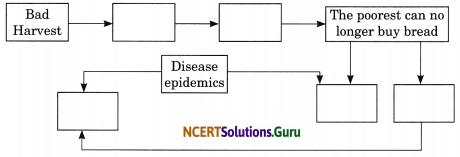
Answer:

Question 3.
Representatives of the Third Estate take the oath raising their arms in the direction of Bailly, the President of the Assembly, standing on a table in the centre. Do you think that during the actual event Bailly would have stood with his back to the assembled deputies? What could have been David’s intention in placing Bailly the way he has done?
Answer:

Preparatory sketch for a large painting by Jacques-Louis David.
The painting was intended to be hung in the National Assembly.
I don’t think that during the actual event Bailly would have stood with his back to the assembled deputies. What David, the artist intend to show is that the constitution of 1791 that came into existence two years after the French Revolution, had turned its back on the hopes and aspirations of the peasants, labourers and women, instead of meeting them and listening to their problems. Despite the Declaration of the Rights of Man and Citizen, not all citizens had the right to vote. Only the rich and the propertied class enjoyed the voting right. The remaining men and women were classed as passive citizens.
![]()
Question 4.
Look carefully at the painting and identify the objects which are political symbols you saw in Box 1 on NCERT T.B pages 12-13 (broken chain, red cap, fasces, Charter on the Declaration of Rights). The pyramid stands for equality, often represented by a triangle. Use the symbols to interpret the painting. Describe your impressions of the female figure of liberty.
Answer:
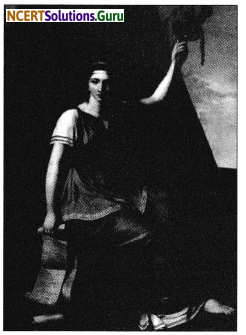
Nanine Vallain, Liberty.
This is one of the rare paintings by a woman artist. The revolutionary events made it possible for women to train with established painters and to exhibit their works in the Salon, which was an exhibition held every two years.
The painting is a female allegory of liberty -that is, the female form symbolises the idea of freedom. The scroll in the right hand of the woman stands for the Declaration of the Rights of Man and Citizen. In the left hand she is holding aloft the red cap symbolising the torch of freedom. The pyramid in the background symbolises equality as all the three sides of a pyramid are equal. The female figure of liberty symbolises the equality of man and woman.
Question 5.
Describe the persons represented in figure given below – their actions, their postures, the objects they are carrying. Look carefully to see whether all of them come from the same social group. What symbols has the artist included in the image? What do they stand for? Do the actions of the women reflect traditional ideas of how women were expected to behave in public? What do you think: does the artist sympathise with the women’s activities or is he critical of them? Discuss your views in the class.
Answer:
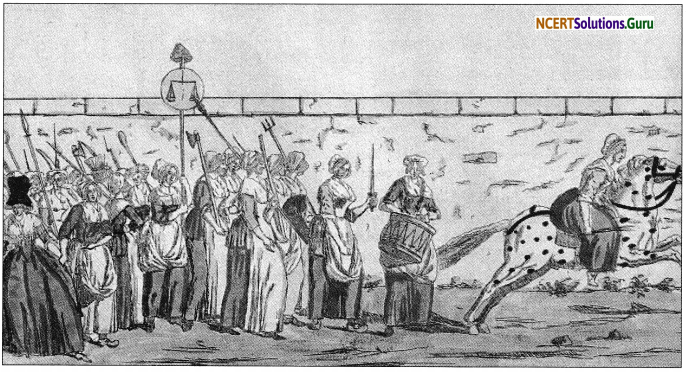
This print is one of the many pictorial representations of the events of 5 October 1789,
when women marched to Versailles and brought the king back with them to Paris.
The persons represented here are the Parisian women who are on their way to Versailles. Being fed up with the king and the existing system these women are seen ready to do anything for the betterment of their condition. All these women are carrying agricultural implements to use them in the storming of Bastille.
Yes, all of them come from the same social group—the peasantry class. One of the woman is carrying aloft the symbol of justice. This symbolises that these women want justice and they won’t sit unless they get it. The woman on the horse symbolises power and strength. The drum symbolises that they are proclaiming their march to all concerned.
The actions of the women do not reflect the traditional ideas of how women were expected to behave in public. These women are not afraid of anyone. They are determined to force the king to pay attention to their condition.
Yes, the artist appears to be a great sympathiser of these women and their activities.
![]()
Question 6.
Compare the manifesto drafted by Olympe de Gouges with the Declaration of the Rights of Man and Citizen.
Answer:
The manifesto drafted by Olympe de Gouges gives emphasis on the equality of women. She says that women like men are born free and must remain equal to men in rights. On the other hand the Declaration of the Rights of Man and Citizen does not mention women at all. It only talks about men and their rights.
While Olympe de Gouges supports the idea of preservation of the natural rights of woman and man, the Declaration of the Rights of Man and Citizen supports the idea of preservation of the natural rights of man only.
Question 7.
Describe the picture in your own words. What are the images that the artist has used to communicate the following ideas; greed, equality, justice, takeover—by the state of the assets of the church?
Answer:
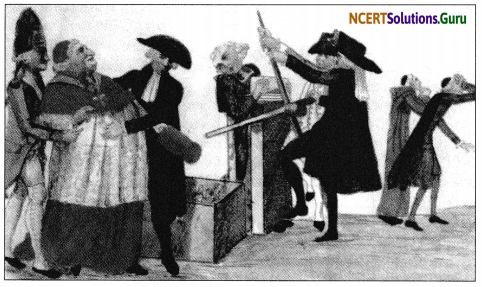
This anonymous print of 1790 seeks to make the idea of justice tangible.
Greed is symbolised by the fat clergyman on the extreme left.
The two men holding him symbolise government officials who under the instruction of the clergyman have taken over the assets of the church.
The man and woman in the extreme right symbolise equality.
In the middle is standing the press which symbolises justice.
History Class 9 Chapter 1 NCERT Textbook Questions and Answers
Question 1.
Describe the circumstances leading to the outbreak of revolutionary protest in France.
Answer:
The following circumstances led to the outbreak of revolutionary protest in France:
(i) The eighteenth century French society was divided into three estates the clergy, the nobility and the third estates which included businessman, officials, peasants and artisans. The clergy and nobility were exempted from taxes. Only the third estate had to pay taxes.
(ii) The population of France increased immensely in the 1780s. This led to a rapid increase in the demand for food grains. Production of grains could not keep pace with the demand. So the price of bread which was the staple diet of the majority rose rapidly.
(iii) Most of the workers were employed as labourers in workshops whose owner fixed their wages. But the wages did not keep pace with the rise in prices. So, the gap between the poor and the rich widened which created dissatisfaction among the poor.
(iv) To meet its regular expenses, such as the cost of maintaining an army, the court, running government offices or universities, the state was forced to increase taxes. The burden of increased taxes fell on the third estate only.
(v) On 5 May 1789, the King called together an assembly of the Estates General to pass proposals for new taxes. The first and second estates sent 300 representatives each, who were seated in rows facing each other on two sides, while 600 members of the third estate had to stand at the back. Voting in the Estates General in the past had been conducted according to the principle that each estate had one vote. This time too Louis XVI was determined to continue the same practice. But the members of the third estate demanded that each member would have one vote. When the king rejected this proposal, they walked out of the assembly in protest.
(vi) Meanwhile a severe winter in France caused severe hardships to the poor. Due to bad harvest, the price of bread rose. The bakers exploited the situation and hoarded supplies. After spending hours in long queues at the bakery, crowds of angry women stormed into the shops. At the same time, the king ordered troops to move into Paris. On 14 July 1789, the agitated crowd stormed and destroyed fortress-prison, the Bastille. This led to the outbreak of revolutionary protest in France.
![]()
Question 2.
Which groups of French society benefited from the revolution? Which groups were forced to relinquish power? Which sections of society would have been disappointed with the outcome of the revolution?
Answer:
(i) The wealthier middle class people who were also educated benefited from the revolution. These people were capable enough to seize power as soon as the Jacobin government fell.
(ii) The privileged class that included the clergy and the nobility was forced to relinquish power. The National Assembly passed a decree that abolished the age-old feudal system of obligations and taxes. Tithes, taxes levied by the church were also abolished and the lands owned by the church were also confiscated.
(iii) Non-propertied sections of society and women would have been disappointed with the outcome of the revolution. These people were classed as passive citizens having no right to vote. Women’s demand for voting rights continued for many years. It was finally in 1946 that they won this right.
Question 3.
Describe the legacy of the French Revolution for the peoples of the world during the nineteenth and twentieth centuries.
Answer:
(i) The ideals of liberty and democratic rights were the most important legacy of the French Revolution.
These ideals spread from France to the rest of Europe during the nineteenth century, where feudal system were abolished.
(ii) Political revolution in Europe began with the French Revolution. This revolution influenced the people in other European countries and political revolutions raged through Europe as people fought against the authority of kings.
(iii) Colonised peoples got inspired by the ideals of the French Revolution. They reworked the idea of freedom from bondage into the movements to create a sovereign nation state. Tipu Sultan and Rammohan are two examples of individuals who responded to the ideas coming from revolutionary France.
![]()
Question 4.
Draw up a list of democratic rights we enjoy today whose origins could be traced to the French revolution.
Answer:
The origins of many of the democratic rights we enjoy today could be traced to the Declaration of the Rights of Man and Citizen, constituted in 1791 after the French Revolution:
- Right to Life
- Right to Equality
- Freedom of Speech, Expression and Thought
- Equality before Law
- Right to Vote and be elected for political offices
- Right to Property
- Right to Resist oppression
- Right to Justice and Security.
Question 5.
Would you agree with the view that the message of universal rights was beset with contradictions? Explain.
Answer:
The message of universal rights was beset with contradictions:
(i) The Declaration of Rights of Man and Citizen laid stress on equality but a large section of society was denied to it. All rights were given to men with property. Non-propertied section and women were ignored totally. They had no right to vote.
(ii) The presence of a huge number of people as passive citizens, without voting rights, was like not putting into practice what you preach. The revolutionary journalist Jean-Paul Marat felt that the Constitution of 1791 had given the task of representing the people to the rich. And the poor were suppressed.
(iii) The Declaration of Rights failed to establish liberty to all. France continued to hold and expand colonies. It tried to give an image of liberator to the world but could not succeed.
(iv) Slavery continued to exist in France for a long time. It was finally abolished in French colonies in 1848.
(v) Jeans-Paul Marat felt that the Declaration of Rights was biased. The law was influenced by the rich. The women were regarded as passive citizens. They were also discriminated on the basis of gender. These were against the ideals of the universal rights.
![]()
Question 6.
How would you explain the rise of Napoleon?
Answer:
The fall of the Jacobin government allowed the wealthier middle classes to seize power. A new constitution was introduced which denied the vote to non-propertied sections of society. It provided for two elected legislative councils. These then appointed a Directory, an executive made up of five members. This was meant as a safeguard against the concentration of power in a one-man executive as under the Jacobians. However, the Directors often clashed with the legislative councils, who then sought to dismiss them.
The political instability of the Directory paved the way for the rise of Napoleon Bonaparte, a military dictator. In 1804, he crowned himself Emperor of France. Then he set out to conquer neighbouring European countries, dispossessing dynasties and creating kingdoms where he placed members of his family. Napoleon view himself as a moderniser of Europe.
He introduced many laws such as the protection of private property and a uniform system of weights and measures provided by the decimal system. In the beginning many saw Napoleon as a liberator who would bring freedom for the people. But soon the Napoleonic armies came to be viewed everywhere as an invading force. He was finally defeated at Waterloo in 1815.
Class 9 History Chapter 1 NCERT Intext Activity Questions and Answers
Question 1.
Find out more about any one of the revolutionary figures you have read about in this chapter. Write a short biography of this person.
Answer:
Do it yourself with the help of internet.
![]()
Question 2.
The French Revolution saw the rise of newspapers describing the events of each day and week. Collect information and pictures on any one event and write a newspaper article. You could also conduct an imaginary interview with important personages such as Mirabeau, Olympe de Gouges or Robespierre. Work in groups of two or three. Each group could then put up their articles on a board to produce a wallpaper on the French Revolution.
Answer:
Do it yourself.
Hope the data shared above regarding the NCERT Class 9 Social Science History Chapter 1 PDF has aided in your exam preparation. If you ever need any assistance you can always reach us and our team will guide you at the soonest possibility.